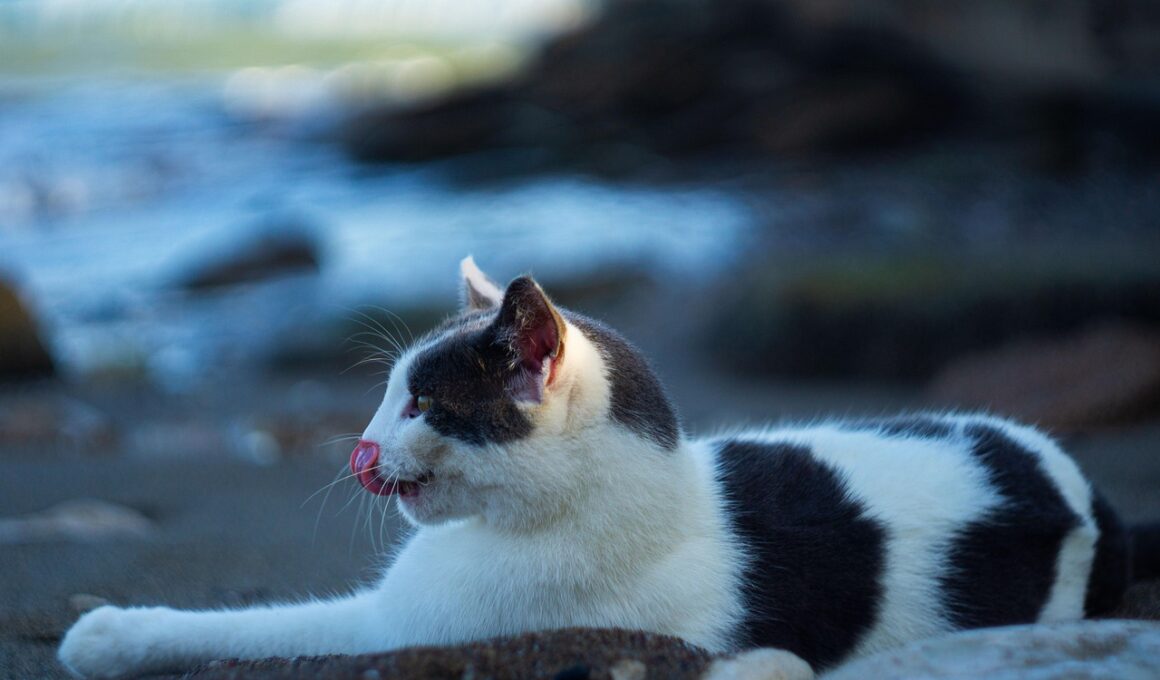Understanding Feline Hyperthyroidism: Key Symptoms to Watch For
Feline hyperthyroidism is a common endocrine disorder affecting older cats, primarily due to an overproduction of thyroid hormones. The condition can lead to various health complications if left untreated. It’s important for cat owners to be vigilant about recognizing early symptoms. Common signs of hyperthyroidism include excessive thirst and urination. Cats may also experience an increase in appetite, despite noticeable weight loss. Hyperactive or restless behavior can alert owners to potential health issues, making it essential to monitor any changes in activity levels. Additionally, hyperthyroid cats often display a poor coat condition, appearing unkempt or dry. Early diagnosis and treatment are crucial to managing the disease effectively and improving your cat’s quality of life. Keep in mind that not all cats will exhibit the same symptoms. Regular veterinary check-ups are advisable for early detection. Blood tests can measure thyroid hormone levels, confirming a diagnosis of hyperthyroidism. If you notice any of these symptoms occurring in your cat, seeking veterinary advice promptly will contribute significantly to better health outcomes for your feline friend. Pay attention to these factors as they could signal underlying health issues.
Another primary symptom of feline hyperthyroidism is changes in behavior and temperament. Affected cats may become more vocal or irritable, signaling their discomfort. Some exhibited characteristics include increased anxiety and a tendency to seek warmth, which can be particularly concerning. Unlike typical deterioration in health, these signs are distinct and require attention. Regular interaction with your cat will help you notice changes that could signal hyperthyroidism or other issues. Besides the behavioral changes, affected felines may also experience gastrointestinal disturbances such as vomiting or diarrhea. These symptoms can often be misinterpreted as other health issues, further complicating the diagnosis. Routine veterinary evaluations are essential as weight loss related to hyperthyroidism can lead to further complications if left untreated. Increased metabolism caused by elevated thyroid hormones affects many bodily functions and requires quick intervention. If multiple symptoms appear simultaneously, it’s advisable to schedule a vet visit for comprehensive evaluation and blood testing. Treatments vary depending on severity, ranging from medication to dietary changes and even surgery in some severe cases. Observing your cat closely can play a pivotal role in managing their health effectively.
Treatment Options for Feline Hyperthyroidism
There are various treatments available for feline hyperthyroidism, each designed to reduce excessive hormone levels and restore normal function. One common approach involves anti-thyroid medications that help inhibit hormone production. These medications can require continuous administration, necessitating regular vet visits for monitoring. It is vital to follow the veterinarian’s instructions regarding dosage and schedule. Some cats may also benefit from a special prescription diet formulated to control thyroid hormone levels. These diets restrict iodine intake, an essential component for thyroid hormone synthesis. In some cases, a more permanent solution may be radioiodine therapy, which effectively destroys overactive thyroid tissue, leading to a long-lasting impact on the cat’s health. This treatment often yields high success rates but might require specialized facilities. Surgical removal of the affected thyroid gland is another option, though it usually entails higher risks and potential complications. It is important to weigh all options with your veterinarian, taking into consideration your cat’s overall health and age. Each treatment option has its pros and cons, so understanding them fully will assist you in deciding which route to take for your feline’s care.
Regular follow-up visits are crucial after initiating treatment for feline hyperthyroidism. Continuous monitoring helps assess your cat’s thyroid hormone levels and overall health status. Adjustments in medication or dietary plans may be required based on these observations. It is essential to engage with your veterinarian actively, ensuring that any new symptoms or behaviors are reported promptly. This will allow for timely modifications to the treatment plan. Besides monitoring, creating a stress-free environment can also benefit your cat. Reducing stressors can enhance their well-being, particularly since hyperthyroidism may lead to increased anxiety. Simple changes such as maintaining a stable routine or providing comfortable resting places can positively affect your cat’s behavior. Ensure that your cat stays hydrated and encourage frequent drinking, as increased thirst is a symptom to manage. Observe their eating habits as well; slow, controlled feeding can limit gastrointestinal upset. Be aware of potential side effects associated with the prescribed treatment. Understanding these helps you respond quickly if any adverse reactions arise. Ultimately, maintaining an open line of communication with your veterinarian is key for the best possible outcome.
Complications of Untreated Hyperthyroidism
If left untreated, feline hyperthyroidism can lead to serious complications affecting your cat’s well-being. Prolonged overactivity of the thyroid gland can result in heart problems, notably hypertrophic cardiomyopathy, a condition where the heart muscle thickens. This can lead to decreased heart function and various symptoms associated with heart disease. It’s also common for hyperthyroid cats to develop high blood pressure, increasing the risk of vascular damage or organ failure. Cats that are older and have pre-existing conditions may face an even higher risk of complications. Thus, prompt treatment is crucial to prevent such severe health issues. Additionally, improper management of the disorder can lead to weight loss or muscle wasting, severely impacting the cat’s life quality. Cognitive function may also decline, leading to behavioral changes or confusion. Preventive care through routine vet visits can help mitigate these risks. Regular health check-ups allow for early detection of any changes in overall health status. Moreover, educating yourself about hyperthyroidism is vital. Gaining a deeper understanding of the condition empowers you to make informed decisions regarding your cat’s health.
When it comes to feline hyperthyroidism diagnosis, a mix of clinical signs and comprehensive blood tests are utilized. Veterinarians typically look for distinctive symptoms along with elevated levels of thyroid hormones in blood samples. The diagnosis process usually involves a thorough physical examination and a series of tests. Besides typical blood work, ultrasound exams can further help assess the thyroid gland’s condition, providing deeper insights. Correct diagnosis is critical to formulating an effective treatment plan and achieving the desired outcomes. Keeping track of changes using observation practices will help in discussing concerns with your vet. Performing these checks enables a reward system for both owner and cat, contributing to a healthier lifestyle overall. Once a diagnosis confirms hyperthyroidism, multiple factors dictate treatment options based on individual circumstances. Financial considerations, along with the severity of symptoms, also play roles in your treatment pathway. Your veterinarian can break down these options, making them more comprehensible for you. Having an ongoing dialogue with your vet aids in making suitable health choices that best align with your cat’s needs, so continuous support is essential.
Conclusion: Ensuring Your Cat’s Health
In conclusion, keeping a close eye on your cat’s behavior and health is crucial for early detection of feline hyperthyroidism. The symptoms vary between individuals yet often encompass changes in appetite, weight, energy levels, and overall demeanor. As a responsible pet owner, understanding these signs, along with the potential for complications, is essential. Taking timely action in scheduling veterinary visits can lead to improved treatment outcomes. Consistent follow-up appointments, effective communication with your vet, and available treatment options can subsequently enhance your cat’s quality of life. Stress management remains integral to their overall well-being. Engage with your feline friend daily, fostering bonding and helping to reduce anxiety. Moreover, by educating yourself about feline hyperthyroidism, you equip yourself with necessary knowledge, translating to better health management for your pet. This awareness not only aids in preventive health care but also encourages proactive strategies against potential health issues. In fostering a nurturing environment and being responsive to changes, you can ensure your beloved cat remains happy and healthy. Remember, your vigilance is key in identifying changes and seeking timely medical intervention.
Utilizing resources, both literature and veterinary professionals, can further support your knowledge of feline hyperthyroidism. Accessing trustworthy online material, publications, and articles dedicated to the subject can enrich your understanding. Equally, your vet will be a vital part of your journey, offering expert advice tailored to your cat’s unique needs. Forming a strong partnership with your veterinarian empowers you to make informed choices concerning healthcare decisions for your pet. Furthermore, participating in support groups with other cat owners experiencing similar challenges can offer insights and shared experiences. Engaging in these conversations may provide different perspectives while relieving some stress felt through the process. Remember that you are not alone in this journey. Local organizations may also host workshops or webinars about feline health and well-being. Exploring community resources expands your network and cultivates better overall knowledge for managing your cat’s condition. Keeping organized records of your cat’s symptoms and treatment responses can facilitate effective discussions at vet appointments. Through these efforts, you can work together with veterinary professionals, ensuring the health and happiness of your loved cat in the long term.


